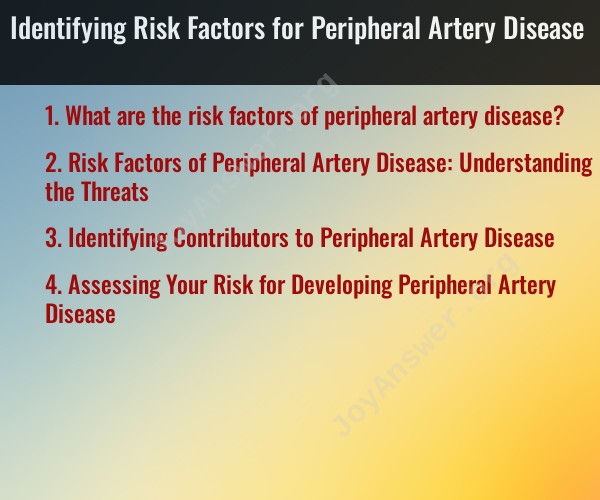What are the risk factors of peripheral artery disease?
Peripheral Artery Disease (PAD) is a circulatory condition that occurs when the arteries that supply blood to the extremities, most commonly the legs, become narrowed or blocked. Several risk factors can increase the likelihood of developing PAD. These risk factors include:
Smoking: Smoking is one of the most significant risk factors for PAD. It damages the blood vessels and accelerates the progression of atherosclerosis (plaque buildup in the arteries).
Age: The risk of developing PAD increases with age, especially in individuals over the age of 50. Aging can contribute to the natural hardening and narrowing of arteries.
Diabetes: People with diabetes are at a higher risk of developing PAD. High blood sugar levels can damage the blood vessels and contribute to atherosclerosis.
High Blood Pressure (Hypertension): Uncontrolled high blood pressure can damage the blood vessels and increase the risk of atherosclerosis.
High Cholesterol: Elevated levels of LDL (low-density lipoprotein) cholesterol, commonly referred to as "bad" cholesterol, can lead to plaque buildup in the arteries.
Family History: A family history of PAD or other cardiovascular diseases can increase the risk. Genetic factors may play a role in the development of atherosclerosis.
Obesity: Being overweight or obese puts additional stress on the circulatory system and is associated with an increased risk of PAD.
Physical Inactivity: A sedentary lifestyle can contribute to poor circulation and muscle deconditioning, both of which increase the risk of PAD.
Gender: Men are generally at a higher risk of developing PAD than women. However, the risk for women increases after menopause.
Ethnicity: Certain ethnic groups, such as African Americans, may have a higher risk of PAD.
Other Cardiovascular Conditions: Individuals with a history of other cardiovascular conditions, such as coronary artery disease or stroke, are at a higher risk of PAD.
Inflammatory Conditions: Inflammatory conditions, such as rheumatoid arthritis, can contribute to arterial inflammation and increase the risk of PAD.
Elevated Homocysteine Levels: High levels of homocysteine, an amino acid in the blood, have been associated with an increased risk of atherosclerosis and PAD.
Kidney Disease: Chronic kidney disease can lead to a buildup of waste products and an increased risk of arterial damage.
Previous Arterial Injuries or Surgeries: Individuals who have had arterial injuries, surgeries, or radiation therapy to the chest are at an increased risk.
It's important to note that having one or more of these risk factors doesn't necessarily mean you will develop PAD, but they can increase your risk. Reducing the risk of PAD often involves lifestyle modifications and the management of underlying health conditions. This may include quitting smoking, managing diabetes and blood pressure, maintaining a healthy weight, engaging in regular physical activity, and following a heart-healthy diet. If you have multiple risk factors or experience symptoms such as leg pain or cramping during physical activity, it's essential to consult a healthcare provider for evaluation and appropriate management. Early diagnosis and intervention can help prevent the progression of PAD and reduce the risk of complications.
Risk Factors of Peripheral Artery Disease: Understanding the Threats
Peripheral artery disease (PAD) is a condition in which the arteries that carry blood to the legs and feet become narrowed or blocked. This can reduce blood flow to the legs and feet, which can cause a variety of symptoms, including pain, numbness, and cramping. In severe cases, PAD can lead to gangrene and amputation.
There are a number of risk factors for PAD, including:
- Age: PAD is more common in people over the age of 65.
- Smoking: Smoking is the leading risk factor for PAD.
- Diabetes: Diabetes damages blood vessels and can increase the risk of PAD.
- High blood pressure: High blood pressure can damage blood vessels and increase the risk of PAD.
- High cholesterol: High cholesterol can build up in the arteries and narrow them, which can lead to PAD.
- Obesity: Obesity is a risk factor for PAD, especially in men.
- Family history of PAD: If you have a family history of PAD, you are at an increased risk for developing the disease.
Identifying Contributors to Peripheral Artery Disease
There are a number of factors that can contribute to PAD, including:
- Atherosclerosis: Atherosclerosis is a condition in which plaque builds up on the walls of the arteries. This can narrow or block the arteries, reducing blood flow.
- Blood clots: Blood clots can form in the arteries and block blood flow.
- Vasculitis: Vasculitis is a condition that causes inflammation of the blood vessels. This can damage the blood vessels and increase the risk of PAD.
- Raynaud's syndrome: Raynaud's syndrome is a condition that causes the blood vessels in the fingers and toes to narrow in response to cold or stress. This can reduce blood flow to the fingers and toes and increase the risk of PAD.
Assessing Your Risk for Developing Peripheral Artery Disease
If you have any of the risk factors for PAD, it is important to talk to your doctor about your risk. Your doctor can assess your risk and recommend ways to reduce your risk.
Here are some things you can do to assess your risk for developing PAD:
- Know your family history: If you have a family history of PAD, you are at an increased risk for developing the disease.
- Get regular checkups: Your doctor can check your blood pressure, cholesterol, and blood sugar levels during regular checkups. These factors can all increase your risk of PAD.
- Quit smoking: Smoking is the leading risk factor for PAD. Quitting smoking is the best thing you can do to reduce your risk of developing PAD.
- Eat a healthy diet: Eating a healthy diet can help to lower your blood pressure, cholesterol, and blood sugar levels. These factors can all increase your risk of PAD.
- Exercise regularly: Exercise can help to improve your blood circulation and reduce your risk of PAD.
If you are concerned about your risk for PAD, please talk to your doctor. They can help you to assess your risk and develop a plan to reduce your risk.













